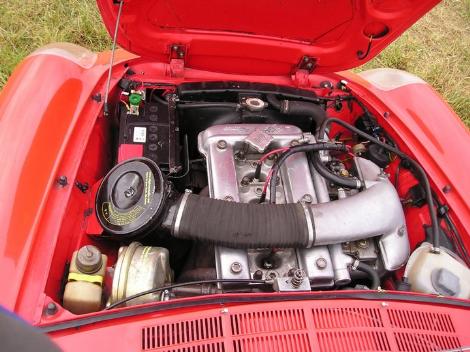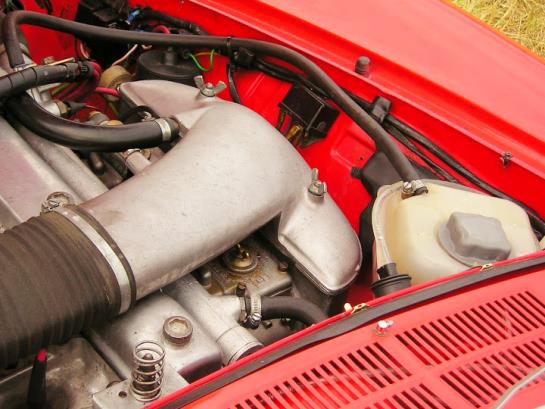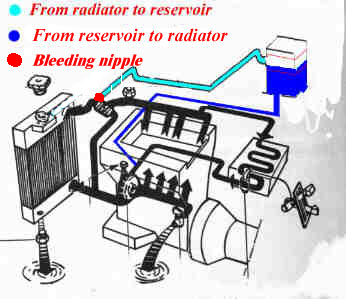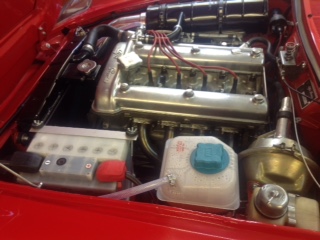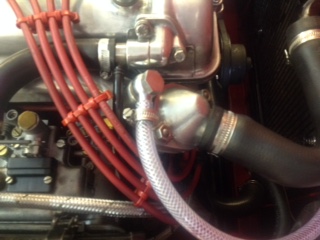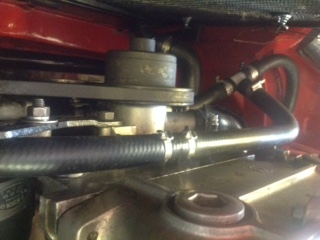|
Radiator and coolant, not just plain water. The modified cooling system.
|
|
The radiator on your Spider is awful big. The car normally runs very cool and high speed for hours on motor-way driving is no problem. Check that the temperature gauge is steady and doesn't move once the engine is warm. If the gauge starts to move up and down so you may notice how it's moving, you might have a blown head gasket. If so, open the heater to check if there's enough water in the system. If you cannot feel the hot air and the gauge is nervous, stop the engine and have a look at the system. There is a plastic reservoir where you
may see the coolant level. I have some modification ideas how
to save the head gasket and to bleed the system automatically
further in this
Be careful, hot water is very hot! Before starting the engine, have look for oil in the system. This looks like old cream or mayonnaise. The emulsion is a bad sign and needs to be controlled. As I said before, blown gasket or the O-rings are usually the answer. It is true that pure water will transport heat better than a mixture of 50% antifreeze and 50% water.. It is also true that one liter of water can "carry" more heat from the engine block to the radiator than one liter of the anti freeze mixture. But that's not the whole story. Think about it this way. When you boil water in a saucepan, the bottom will heat the water and soon small bubbles of steam will start going upwards. The bubbles will be cooled by the water an condense before reaching the surface. They won't reach the air until all surrounding water has reached the boiling temperature.
That's what happens in the engine too. Your Spider has a bleeding valve close to the thermostat. Be sure to bleed your system carefully. The hot surfaces in the engine produce small steam bubbles but they will never reach the radiator, since they are being cooled on the way. This is what happens as long as the water is below its boiling temperature. But if the temperature increases, steam will replace the water and steam is a lousy heat transporter. The radiator is there to transform the hot coolant to a lower temperature. The bigger difference between the coolant and the cooling air outside the radiator, the more efficient will the radiator do its work. That's where the anti freeze is necessary. A mixture of antifreeze and water, say 50 per cent, may reach a higher temperature before boiling. This increased temperature will help the coolant to reach a higher temperature without boiling. Modern cars have sealed cooling systems and are designed for higher temperatures. Don't forget the water pump. When the pump is spinning around, it might produce small steam bubbles too, due to at high revs. This might also happen inside your engine. The wet liners and the engine block in your Alfa are moving every time a piston moves. This movement and vibration also give the coolant hard work. When the caviation bubble hits the wall inside the engine, liners suffer and the cast iron deteriorates. Don't panic. Always use anti freeze in your coolant. The mixture acts as a shock absorber, gives a better cooling effect, prevents rust and corrosion and lubricates the water pump! No more blown head gasket! No more bleeding the system! One thing that sometimes causes problem with the Alfa engine is a blown head gasket. I noticed that when driving long distances the coolant evaporated and the pressure forced the air into the drainpipe leading to the reservoir. The loss off coolant was normal, the gasket was tight, but I had to refill the radiator now and then every season. Since the hose between the radiator and the reservoir makes a loop before connected to the bottom of the reservoir, the air stayed at the highest point, i.e. the hose.
When the engine was cooling down, the
valve in the radiator cap was opening to let new coolant into
the radiator. This works fine if the hose is totally full with
coolant but it is not. The air will be sucked into the
radiator instead, as the reservoir is placed a bit lower than
the highest level of the radiator. Air is always on top of the
hose, check your own engine. If you have a transparent hose
you know what I mean. This goes for every Alfa Romeo of the
105 and 116-series. The Milano or 75 and later versions of the
Alfa GTV has this type of cooling system already. I think Alfa
Romeo introduced it in the mid -80's. It was also quite tricky
to bleed the system to get all the air out. I have tried
everything, incl. raising the front of the car. Now I am
through with all that. This is the modified system. It will
work under pressure as before so use the cap that comes along
with the I got a reservoir of a modern type with two hoses from the junk yard. I found that the reservoir from a Volvo 340 was excellent. It is square, has two connections and is big enough. Most reservoirs are shaped to fit a special model, but this one was neutral. The reservoir was mounted in the engine bay on the right side (I have an old 105-engine with the air filter over the exhaust manifold). You may place it to the left where the original reservoir is. I connected the bigger bottom hose
using a T-pipe connection from an Alfa 33 to the water pump. I
used a short hose between the water pump and the T-connection
and the original hose from the heater was attached to the
T-connection. Noted that as I have a 1750 engine, there are
only two intakes. The later pumps have three connections:
from the radiator, from the heater and finally from the
thermostat. The later is missing on the 1750 pump, so that is
the reason for the The smaller hose was then connected to the thermostat housing. That is the red dot. I got a bleeding nipple at the junk yard from a Ford. They are standard on any European car. The hose was attached to the new reservoir. That's it. The bleeding nipple has a hole allowing the coolant to pass through into the reservoir. The air will stay in the reservoir. Easy, right? Now, place the new reservoir at a suitable place in the engine bay, but place it as high as possible. It must be higher than the radiator so the water level is higher than the level of the radiator. Note the level on the reservoir using a marking pen or whatever. Refit the cap of the radiator and add some extra water in the reservoir. Keep the high pressure cap that comes with the reservoir. The system is designed to work under pressure. I used a regular stick to check the level of coolant in the reservoir. I placed the stick on top of the engine to see how much I needed to add to get the maximum level of coolant. Well, it is just about trial and error.
Start the engine. If you have done it properly, a small string of water will go through the top of the radiator into the reservoir and always keep the engine with enough coolant and hopefully no more overheating. For those of you who say "it is not original", I know. It is just the same method used on the Alfas from 1980 and on, Milano, 75, GTV etc.
Here is a Duetto using the modified system.
Thanks to Erik Nielsen, Denmark. VIN 1412753
|
